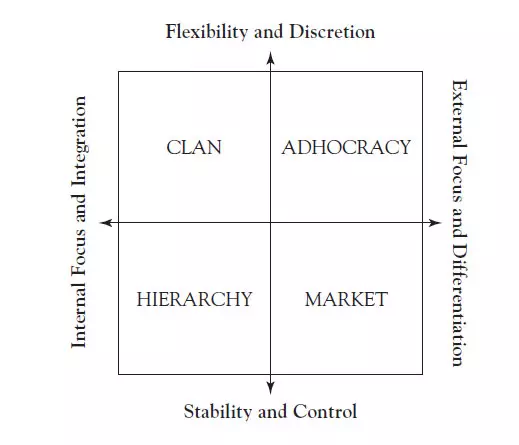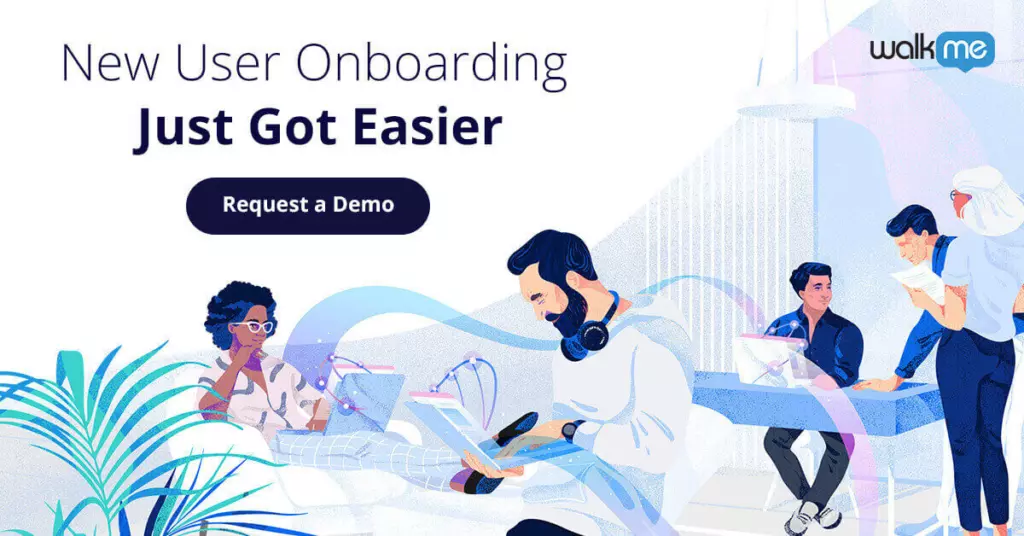Organizational culture in the digital age looks very different than it did in the past.
Organizational culture is “how things are done around here” and this dictates the core values, underlying beliefs, change management processes, and standards that thrive in an organization.
Assessing different culture types
Quinn and Cameron developed the Competing Values Framework Model, which maps out four different organizational models or cultural types found in businesses. These types are:
- Clan
- Hierarchy
- Adhocracy
- Market

Credit: Study.Generalia
Clan Culture
The first two, clan and hierarchy, exist in more traditional organizational cultures as well as digital ones. For example, a clan culture will have a focus on nurturing through interpersonal connections or mentoring programs and will create a feeling in the company of an extended family.
This applies to many small businesses or companies that are quite literally, family-run. This type of organizational culture is intimate, and although it might work for teams within larger organizations, it’s not a scalable culture for a large enterprise. Communication in this type of culture must stay minimal and simple. Complex processes or projects are difficult (or near impossible) to achieve within a clan culture.

Hierarchical Culture
A hierarchical culture is one that is highly structured by responsibility and role. Power and influence are very much consolidated at the top of the organization. In this type of culture, those at the top hold all of the cards and those at the bottom often feel very powerless. While this type of organizational culture can be very efficient, it’s not an environment that fosters creativity or innovation.
Market Culture
Conversely, the other two cultures, adhocracy, and market, are more suited for businesses that are digitally enabled and determined to scale. Market culture is result-orientated. This culture values competitive endeavors and rewards achievements. Market culture demands high performance out of employees, but also offers real payoffs for success. This culture is very productive among sales organizations. Salespeople are often motivated by high stakes and big rewards.
Adhocracy Culture
Finally, an adhocracy is a culture in which risk-taking is encouraged, with a dynamic and entrepreneurial environment that values innovation. In this more modern and dynamic organizational structure, all employees are given incentives to contribute, regardless of their rank or role.
As the workplace changes, so does the definition of organizational culture. Quinn and Cameron discovered through studying organizational types, that flexible organizations are more likely to succeed than rigid ones.

For the modern leader, carefully choosing and enforcing the organizational culture is imperative for driving success.
Company structure
How a company is structured will have a significant impact on their organizational culture. Even within a more flexible organization, there will be some departments that are more rigid, like finance and others, which encourage innovation like product and marketing. A company that is extremely segmented or siloed will struggle to succeed in the digital era, which is all about the sharing of information to enable quick decision making using real-time insights. Digital strategy can accommodate this challenge by keeping departments aligned and connected with digital adoption.
The digital age is also bringing the customer experience into focus. Silos can be of detriment to the customer, and they can cause a slower response time and even create double work. Key signs or indicators of customer dissatisfaction may be missed just because they were seen by the wrong part of the organization at the wrong time leading to churn.
One way to break down departmental silos is to implement an effective CRM platform. These allow multiple departments to access and input information on an individual customer so that all stakeholders are privy to the same information at each step of the sales funnel.
This sharing of information will help break down the silo’s that exist between departments and ensure relevant customer information isn’t hidden or ignored. Ensuring that CRM implementation comes along with a digital adoption solution is imperative for its full utilization and employee buy-in.

Aversion to risk
In the report, “Culture for a Digital Age,” McKinsey identifies that fear of taking risks is one of the biggest contributing factors to companies not succeeding in a digitally enabled market.
Enabling a risk-taking culture within an organization is something that has to be encouraged by the leaders. We are not suggesting that managers should act in a way that is dangerous to the company’s integrity, but making bold decisions could pay off in dividends.
If leaders want to encourage experimentation and innovation throughout all ranks, they must lead by example while also taking away the aversion to risks. Digital transformation goals can help leaders determine which risks are worthwhile.
This means allowing greater autonomy throughout the organization and empowering more employees to take on responsibility. For example, arming call center employees with real-time analytics and giving them enough information and autonomy to solve a customer’s problem, can be a cost-effective and empowering way to streamline support. Excellent tools and seamless digital adoption are the key to fostering these situations.
Agility
The digital age means that change happens quickly, and if your business can’t adapt to those changes, then you are at risk of being left behind.
Organizational agility refers to the ability of a business to pivot and change when the need arises, without causing major disruption to the day-to-day. Just like risk-taking, agility is something that must run through the entire organization for it to be effective. It also requires employees to welcome change versus resisting change.
In the digital workplace, where change is a constant, agility will be of critical importance. Modern leaders recognize the value agility can offer to a business and should invest in agility training. Employees will learn vital skills for handling change management, timekeeping, and prioritizing tasks.

Furthermore, an agile company will invest in continual learning and development. This doesn’t have to mean regular classroom training sessions. Quite the opposite, it’s delivering training in a way that doesn’t disrupt their day-to-day. Digital adoption platforms provide in-app training and learning capabilities so that employees don’t have to train outside of their work-time.
By leveraging tools such as contextual learning software, team leaders can be assured that their staff is receiving the right training at the right time. With helpful pop-ups and videos which help guide an employee through a process learning new functions or technologies can be done in the flow of work.
Focus on customers
In the digital age, the customer and their needs are the focus. With the growth in social media usage and the ability to make public complaints, the customer has never had so much power.
Modern leaders who understand this recognize the impact customers can have on a brand and its integrity, which is why so many companies choose celebrities and influencers to advocate for their products. Just like a poor review online or customer complaints on social media can have a devastating effect, having your brand endorsed can see sales skyrocket.
Focusing on the customer is also about being more attentive to their needs. This could range from delivering targeted and appropriate marketing campaigns to using real-time insights to answer a customer query as quickly as possible.
A business is nothing without its customers, and the modern leader will realize that creating a culture that focuses on the customer will create more revenue.
A multi-faceted definition
No one thing defines organizational culture for modern leaders. As with most things in the digital age, it’s a combination of factors that will help lead to success. Organizational culture in the digital age will incorporate open lines of communication, a risk-taking and agile attitude, and a primary focus on the customer and their needs.
As a modern leader, if you can balance these factors, and foster a healthy and strategic organizational culture, you will see your organization thrive in the digital age.

